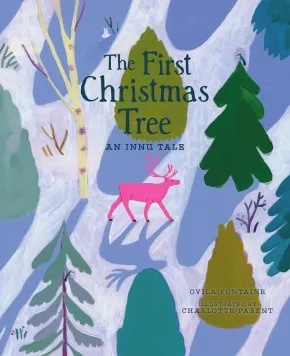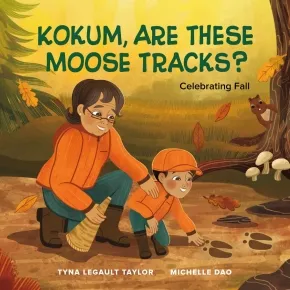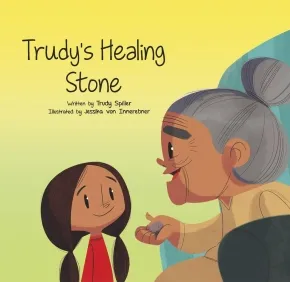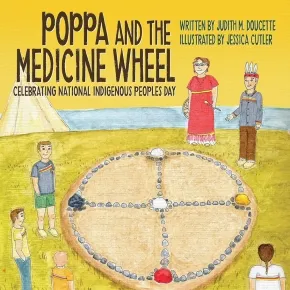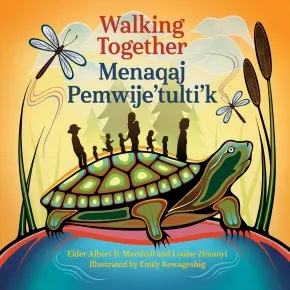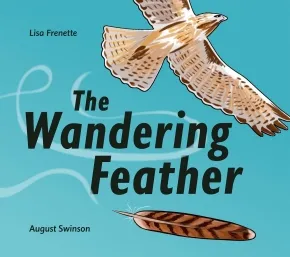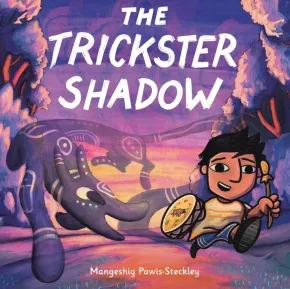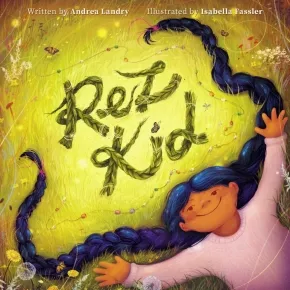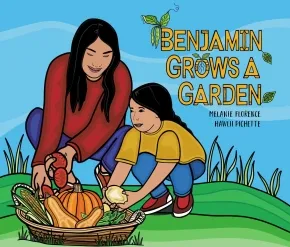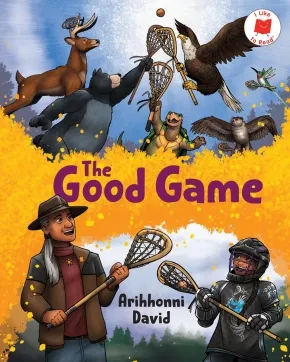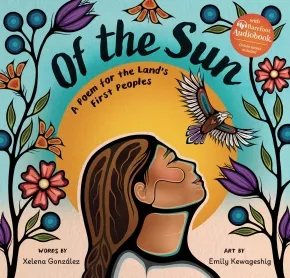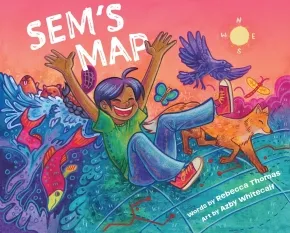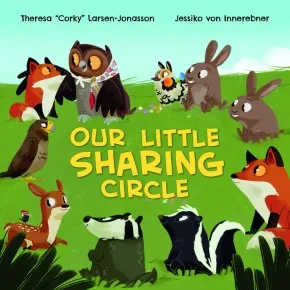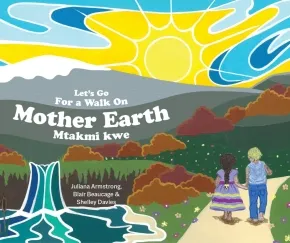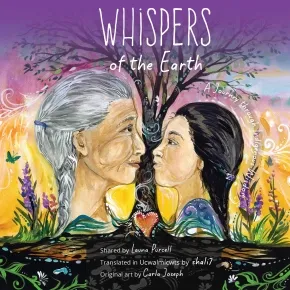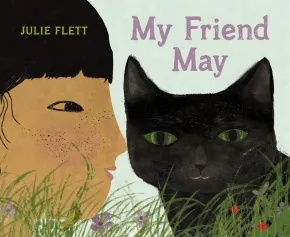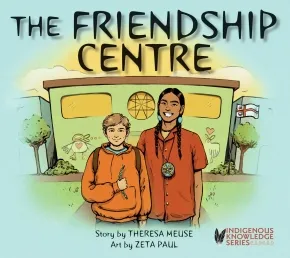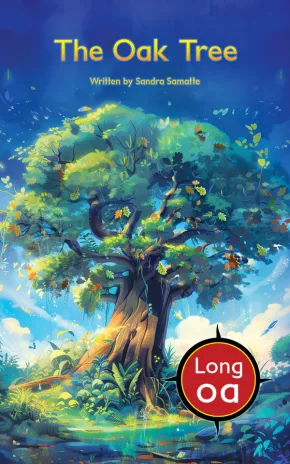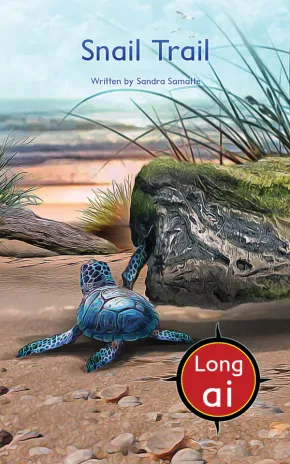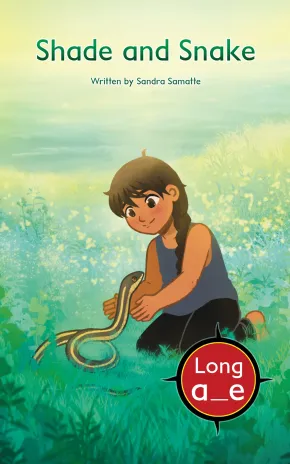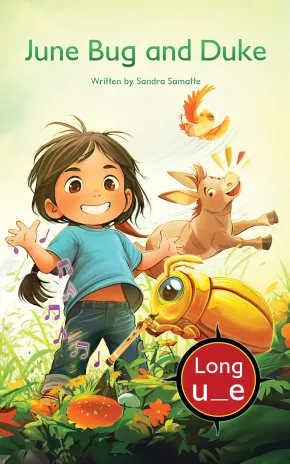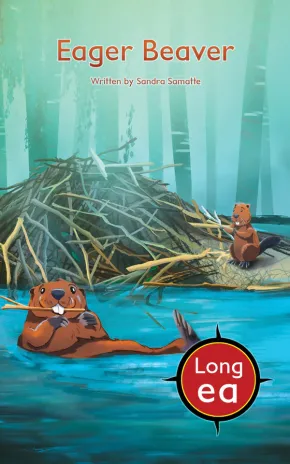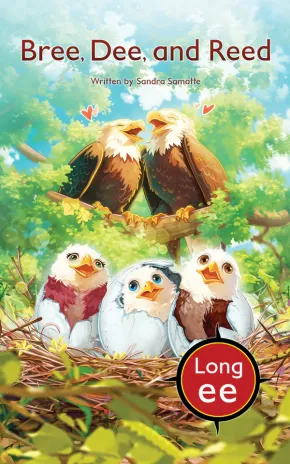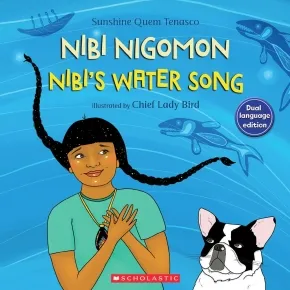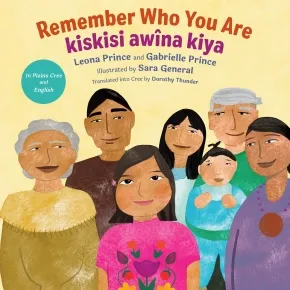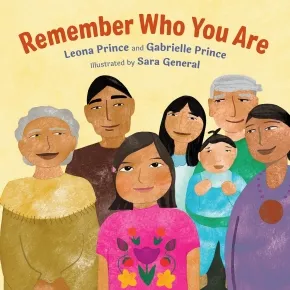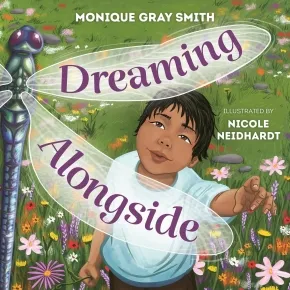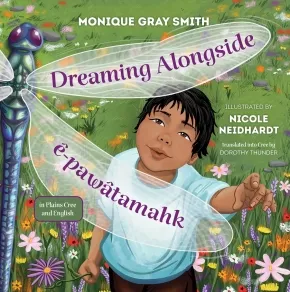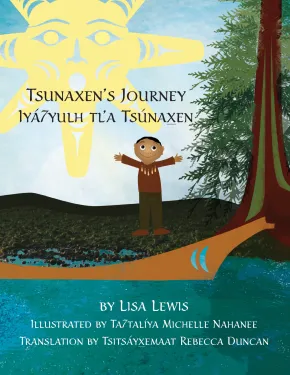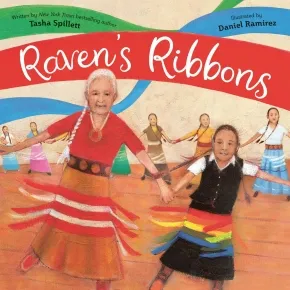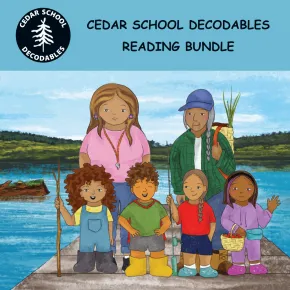
First Nations
1
-
15
of
277 Results;
Sort By
Go To
of 19
The First Christmas Tree: An Innu Tale
$24.95
Artists:
Format:
Hardcover
Text Content Territories:
Indigenous Canadian; First Nations; Innu (Montagnais-Naskapi);
Grade Levels: Preschool; Kindergarten;
ISBN / Barcode: 9781459841802
Synopsis:
Synopsis:
It is very cold in the Far North.
The Great Manitou knows that winter is the harshest season for the Innu, and he decides to find a way to make their winters a little brighter. He searches through the trees in the forest to find one who will bring joy, beauty and warmth to all. Could it be the larch, the tree that the Innu use to make sleds, bows or ointments? The birch, malleable and robust? Or the magnificent black spruce? “Do you want to become the Christmas tree?” he asks each one. But one after the other, the trees decline his offer. All except one, the little fir tree, whom the Great Manitou had initially overlooked.
Reviews
“The Great Manitou appears in vibrant fuchsia as various woodland creatures, standing out against the cool winter palette. A Christmas-themed look into Indigenous culture tradition that encourages further exploration.”— School Library Journal (SLJ)
Educator Information
Recommended for ages 3 to 5.
This book is available in French: Le premier arbre de Noël.
Additional Information
56 pages | 8.50" x 10.75" | Hardcover
Kokum, Are These Moose Tracks?: Celebrating Fall
$21.95
Artists:
Format:
Hardcover
Text Content Territories:
Indigenous Canadian; First Nations; Anishinaabeg; Ojibway; Cree (Nehiyawak); Swampy Cree ; Attawapiskat;
ISBN / Barcode: 9781774921470
Synopsis:
Synopsis:
Young readers will get ready for autumn on a moose tracking adventure with Joshua and Kokum.
When the harvest begins every fall, Joshua looks forward to eating Kokum's delicious moose meat stew at family feasts. He loves being on the land, and he can't wait to go moose hunting with his kokum.
Joshua and Kokum are careful not to make too much noise as they look for moose tracks in the forest. There are so many different animal tracks and Joshua can find them all. But which ones are moose tracks?
In the back of the book, find a glossary and pronunciation guide for the Omushkegomowin (Swampy Cree language) and Anishaabemowin (Ojibwe language) words featured throughout the story. A wonderful cultural learning experience for 5- to 8-year-olds!
Reviews
"A great learning tool for kids! This book not only teaches Omushkegomowin and Anishinaabemowin words and how to identify different animal tracks, but also, and most importantly, it instills respect for all living creatures and consideration for Mother Nature. I hope to one day harvest a moose with my kids, but in the meantime, we’ll try Kokum’s recipe for moose meat stew." — Chuck Hughes, chef and host of Chuck and the First Peoples' Kitchen
Educator & Series Information
Recommended for ages 5 to 8.
Reading Levels:
- Fountas & Pinnell Text Level Gradient: L
- Lexile measure: 760L
This book is part of the Joshua Learns from the Land series.
Additional Information
40 pages | 8.50" x 8.50" | Hardcover
Trudy's Healing Stone (PB)
$10.95
Artists:
Format:
Paperback
Text Content Territories:
Indigenous Canadian; First Nations; Gitxsan (Gitksan);
ISBN / Barcode: 9781778540691
Synopsis:
Synopsis:
Everyone gets sad, angry, frustrated and disappointed. Difficult emotions are a natural part of life. In this book, Trudy's Healing Stone, Trudy Spiller shares a special teaching about a practice that anyone can use to help them process their feelings with the help of Mother Earth.
Educator Information
Recommended for ages 4-6
This rhyming book is an adaptation of Trudy’s Rock Story for a younger audience (ages 4-6).
A few Gitxsan words and how to say them are included at the end of the book.
This book is also available in French: Le caillou de guérison de Trudy.
Recommended in the Canadian Indigenous Books for Schools 2020/2021 resource list for Grades Pre-K to 1 for English Language Arts.
Additional Information
28 pages | 7.87" x 7.09" | Paperback
Poppa and the Medicine Wheel
$18.95
Format:
Paperback
ISBN / Barcode: 9781774572535
Synopsis:
Synopsis:
June 21 is celebrated all over Turtle Island (North America) as National Indigenous People’s Day. François and his friends are excited to celebrate their first public commemoration of this day with Poppa. They will host a morning sunrise ceremony, including Poppa’s teaching on the Seven Lessons of the Mi’kmaw Medicine Wheel.
In this third book of the “Poppa” series, Poppa celebrates his first National Indigenous People’s Day with his Mi’kmaw Community of St. George’s, Newfoundland and Labrador. He can finally do so without fear of discrimination or oppression. After many years of having to hide his Indigenous ancestry, due to the colonial assimilation of his generation, Poppa’s grandson, François, invites him to his school as a respected Mi’kmaw Elder.
Poppa realizes with much joy that his Indigenous culture is bursting with revitalization and renewed pride in a heritage he feared would be lost and forgotten forever. He does not have to practise his cultural ceremonies in private any longer.
Come, join us as we rediscover the teachings of our Mi’kmaw Medicine Wheel and how our ancestors depended on it as a valuable teaching tool for our Peoples. The lessons of the Medicine Wheel are deeply profound and rich with Indigenous spirituality. The Medicine Wheel begs the utmost respect for the Creator as well as every other living creature in existence.
We are all connected in this great circle of life, and we are encouraged to share in each other’s life journey with the help of our Spirit Guides and ancestors’ guidance. Poppa invites us to participate in celebrating the joy of this day with him. Let’s all seek to find our own balance and reconciliation with love and acceptance that can be found within the realms of our own Mi’kmaw Medicine Wheel.
Educator & Series Information
Recommended for ages 5 to 12.
This book is part of the Poppa series.
Additional Information
32 pages | 8.50" x 8.50" | Paperback
Walking Together / Menaqaj Pemwije’tulti’k
$24.99
Format:
Hardcover
Text Content Territories:
Indigenous Canadian; First Nations; Mi'kmaq (Mi'gmaq);
ISBN / Barcode: 9781834020174
Synopsis:
Synopsis:
This bestselling and award-winning introduction to Etuaptmumk—the gift of multiple perspectives also known as Two-Eyed Seeing—is now available in a bilingual edition that celebrates the Mi’kmaw language and our connections to nature.
Elder Albert D. Marshall is a leading environmental voice who has brought forward the concept of Etuaptmumk, honoring and braiding both Indigenous and non-Indigenous knowledges and ways of knowing for the benefit of all. Walking Together is grounded in this, as well as in the concept of Netukulimk, meaning to protect Mother Earth for the ancestors and for present and future generations. The journey in Walking Together nurtures respectful, reciprocal, responsible relationships with the Land and Water, with plant life and animals, and with other-than-human beings.
Translated by Barbara Sylliboy and Arlene Stevens, Eskasoni First Nation, Unama’ki (Cape Breton), Nova Scotia, the dual-language text in Mi’kmaw and English furthers Elder Marshall’s lifelong work preserving cultural beliefs and creating a strong vision for his people and for the future. Elder Marshall and Louise Zimanyi are working together to promote Land-based learning through storytelling, an approach that has global relevance for protecting biodiversity, climate action, and resilience. Emily Kewageshig’s evocative artwork illustrates the beauty of connecting with nature and encourages readers to strengthen their relationships to the world around them.
Educator Information
Recommended for ages 4 to 7.
Introduces the concept of Two-Eyed Seeing (the gift of multiple perspectives) to young readers.
Bilingual Edition: Mi’kmaw and English.
This book is available in English: Walking Together
Additional Information
40 pages | 9.00" x 9.00" | Hardcover
The Wandering Feather
$22.95
Format:
Hardcover
Text Content Territories:
Indigenous Canadian;
ISBN / Barcode: 9781771476287
Synopsis:
Synopsis:
In this charming debut, a feather from a red-tailed hawk finds its home in a little girl's dreamcatcher
When a gust of wind blows a feather off a flying red-tailed hawk, it marks the beginning of that feather's quest to find a new home. The feather ends up in a squirrel's nest, a woman's hat, and atop a sandcastle-but none of these spots feel right.
Soon, the feather is picked up by a little girl who lovingly takes it home to join two other feathers as part of a special craft project. When the project is complete, the reader discovers that the feather has found its home in a dreamcatcher.
Bright illustrations bring young readers along on this lost feather's search for purpose, and the heartwarming conclusion weaves in a tribute to an Indigenous cultural object.
Educator Information
Recommended for ages 4 to 7.
Fountas & Pinnell Text Level Gradient: M
Lexile measure: AD630L
Additional Information
32 pages | 8.75" x 7.75" | Hardcover
The Trickster Shadow
$24.99
Format:
Hardcover
Text Content Territories:
Indigenous Canadian; First Nations; Anishinaabeg;
ISBN / Barcode: 9780316574518
Synopsis:
Synopsis:
From an acclaimed Ojibwe artist comes a story that offers an empowering universal message about finding inner strength.
Zoon’s shadow is always in his way. It makes a mess of his room, disrupts his class at school, and trips him on the soccer field. Zoon doesn’t know what to do! Until he tells his grandmother about it, and she gives him his grandfather’s drum. Its rhythm is like a heartbeat. If only Zoon can listen to the drum’s song, and ultimately to his own heart, he may yet find a way to thrive alongside his shadow.
Pawis‑Steckley's striking, graphic art brings to vibrant life both the challenges of controlling our trickster impulses and the luminosity of ancestral and inner wisdom, paving the way for us all to listen to our hearts.
Educator Information
Recommended for ages 4 to 8.
Additional Information
40 pages | 10.00" x 10.00" | Hardcover
Across the Ice: How We Saved the Ojibwe Horse
$24.99
Artists:
Format:
Hardcover
Text Content Territories:
Indigenous Canadian; First Nations; Anishinaabeg; Ojibway; Saulteaux; Lac La Croix First Nation (Gakijiwanong);
ISBN / Barcode: 9781536229455
Synopsis:
Synopsis:
Discover the history of the endangered Ojibwe horse and the daring intervention of the Lac La Croix First Nation in this celebration of community, tradition, courage, and hope.
It’s a cold, snowy night at Lac La Croix First Nation, and two siblings are too excited to fall asleep. The horses are coming tonight! Amid the buzz of aunties and uncles and cousins, Nookomis tells a story that began many years ago, when their people shared the land with herds of wild ponies. In a symbiotic relationship, the people provided the horses with food and shelter, while the horses helped them run traplines and travel. But after many years had passed, and the herd had dwindled to four, the government threatened to shoot them. It was time to move the remaining horses to safety—but getting them there would be harder than they thought! Follow the true story of a “heist across the ice” from Ontario to Minnesota and learn how a small herd of hardy, indigenous horses returned years later to their native land. Rich illustrations honor the life of the Ojibwe people over time, as well as the land and living things that have survived under their stewardship.
Educator Information
Recommended for ages 3 to 7.
Additional Information
32 pages | 9.62" x 10.62" | Hardcover
Rez Kid
$21.99
Artists:
Format:
Hardcover
Text Content Territories:
Indigenous Canadian; First Nations; Anishinaabeg;
ISBN / Barcode: 9781525311253
Synopsis:
Synopsis:
A celebration of traditional ways of life and the power of sharing what we have.
”Rez kid!“ The girl ignores the taunt as she hurries to the back of the school bus. She just wants to get home to the reservation, where she can feel safe. One by one, she tells her mom, nóhkom, moshum and aunty about what happened. And one by one they offer her advice on what to do. Each one has a different idea, but each idea is the same at heart: share something from the reservation with the other children. The girl listens, but decides to come up with her own idea. And, as with everything else about her life as a rez kid, her idea grows out of all she has been given by those who came before her.
Andrea Landry has written a beautiful story that celebrates Indigenous ways of life and encourages readers to be proud of who they are. The traditions practiced on the girl’s reservation are showcased as she beads, harvests medicine, gardens and rides horseback with her elders. Isabella Fassler’s stunning art, with swirls of bold colors, evokes the majesty and splendor of nature. The message of showing kindness in response to aggression offers a powerful lesson for all readers. This book could augment social studies lessons on Indigenous cultures and character education conversations about courage, compassion and inclusiveness. An author’s note gives a brief history of reservations/reserves.
Educator Information
Recommended for ages 4 to 7.
Curriculum Connections: Compassion; Courage; Empathy; Inclusiveness; Indigenous peoples; Rural communities
Additional Information
32 pages | 10.00" x 10.00" | Hardcover
Benjamin Grows a Garden
$21.99
Artists:
Format:
Hardcover
Text Content Territories:
Indigenous Canadian; First Nations; Cree (Nehiyawak);
ISBN / Barcode: 9781525303210
Synopsis:
Synopsis:
Readers follow along step-by-step as Benjamin plants and cares for his garden and imagines the harvest to come.
Benjamin loves springtime. The grass grows bright green, the birds sing sweet songs and, best of all, Benjamin and his mother start their garden. In just the right order, they plant mahtâmin (corn), pîmiciwacis (beans), and osawipak (squash) for Three Sisters Soup. They plant strawberries to serve with bannock, then zucchini, tomatoes, cucumbers. Benjamin and his mom lovingly tend to the garden and watch it grow into a plentiful harvest with enough to share. Throughout the whole summer, Benjamin dreams about the fall, when they’ll have all the ingredients for a feast – and everyone will be invited!
In this heartwarming story, award-winning author Melanie Florence evocatively portrays the pleasures and rewards of growing and sharing food. The steps of the gardening process – digging holes, planting seeds, watering – are carefully described, and the yearly cycle of growing, harvesting, eating and then starting again the next year is emphasized. Special attention is paid to the tradition of planting corn, beans and squash together so that each plant by its nature helps the others grow. Benjamin and his mother use Cree words throughout the story, and a pronunciation guide is included at the back of the book for further inquiry. Vivid illustrations by Hawlii Pichette make this a perfect follow-up to the author and illustrator duo’s previous book, Benjamin’s Thunderstorm.
Reviews
"A comforting tale of cohabitation between humans and nature." — School Library Journal, April 2025
Educator Information
Recommended for ages 3 to 7.
Includes Cree words throughout the story. A pronunciation guide is included at the back of the book.
Curriculum Connections: Caring; Growth and changes in plants; Indigenous peoples; Patience; Plants; Word recognition
This book is part of the Benjamin Outdoors series. From dancing in the rain with thunder for a drum to planting a vegetable garden with his mom, Benjamin loves being in nature. With evocative text and vibrant art, this delightful picture book series celebrates the joys of spending time outdoors and weaves in nature-related Cree words.
Additional Information
40 pages | 10.00" x 8.50" | Hardcover
The Good Game (PB)
$12.49
Format:
Paperback
Text Content Territories:
Indigenous;
ISBN / Barcode: 9780823460809
Synopsis:
Synopsis:
How can the small mouse and squirrel play lacrosse with the big animals? A fun Native American tale that first graders can read on their own.
A game of lacrosse is about to begin—with the four-legged animals facing off against the winged animals. Mouse and Squirrel want to join!
But Bear and Deer won’t let animals so small on their team. The birds would welcome the small animals, but Mouse and Squirrel can't fly. The winged team has a clever plan.
This Native American tale about the origin of the bat and flying squirrel is framed by a grandfather sharing a story with his grandson.
Educator & Series Information
Phonics features are noted on the copyright page.
This book has been officially leveled by using the F & P Text Level Gradient(TM) Leveling System. It is a Level I for Grade 1.
The award-winning I Like to Read® series focuses on books for kindergarteners and first graders. Acclaimed author-illustrators create original, high-quality illustrations that support comprehension of simple text and are fun for kids to read again and again with their parents, teachers or on their own!
A Junior Library Guild Gold Standard Selection!
Educator Information
Recommended for ages 4 to 8.
Additional Information
32 pages | 7.77" x 9.99" | Paperback
Of the Sun: A Poem for the Land's First Peoples
$22.99
Format:
Hardcover
Text Content Territories:
Indigenous American; Indigenous Canadian; Indigenous Caribbean; Indigenous Peoples in Mexico; Indigenous South American;
Grade Levels: Preschool; Kindergarten;
ISBN / Barcode: 9798888596500
Synopsis:
Synopsis:
A powerful and hopeful ode to Indigenous children.
Indigenous. Native. On this land, you may roam.
Child of the sun, on this land, you are home.
Of the Sun is an uplifting and mighty poem that wraps the Indigenous children of the Americas in reassuring words filled with hope for a brighter future and reminders of their bond and importance to the land. Each page fills them with pride and awe of their cultural heritage and invites them to unite and inspire change in the world.
Paired with powerful art reflecting cultures of various Indigenous Nations and Tribes, the poem offers all readers a sense of the history and majesty of the land we live on and how we can better care for ourselves and the world when we recognize our connection to the land and to each other.
Written by Xelena González, poet and activist in the Native and Latinx communities, and an enrolled member of the Tap Pilam Coahuiltecan Nation. Bold illustrations by prominent Anishinaabe illustrator Emily Kewageshig depict landscapes across the Americas and children from many backgrounds
Endnotes provide more information on Native and Indigenous unity and activism in younger generations
Reviews
"Of The Sun is a loving homage to the Indigenous peoples of this land—both in González’s beautiful, lyrical poem and Kewageshig’s warm, vibrant Anishinaabe-styled artwork. A wonderful read aloud you must add to bookshelves at home, at school, and in community!" - Traci Sorell, award-winning author of We Are Grateful Otsaliheliga and At The Mountain’s Base
"A luminous song, poem, promise
of cultures and connection,
of kinship and caring,
for Indigenous children across the continent." - Cynthia Leitich Smith, author of Jingle Dancer
Educator Information
Recommended for ages 3 to 5.
Subjects / Themes / Topics Included: Indigenous Peoples in the Americas; Poetry; Land Connection; Inuit Clothing; Traditional Hair Bun (tsiiyéél); Concheros Dance; Three Sisters; La Danza de la Flor de Piña; Smoke Dance; Jingle Dress Dance; Manoomin (Wild Rice); English Words from Indigenous Languages; Indigenous Farming Practices; Bison; Land Back Movement.
Additional Information
32 pages | 10.00" x 9.75" | Hardcover
Sem's Map
$14.95
Artists:
Format:
Paperback
Text Content Territories:
Indigenous Canadian; First Nations; Mi'kmaq (Mi'gmaq);
ISBN / Barcode: 9781774714966
Synopsis:
Synopsis:
From the author of I'm Finding My Talk comes a candid picture book about the importance of Indigenous place names, and acknowledging traditional lands.
Sem is confused. The map Mr. Trainer has just put on the screen is all wrong. It's the same shape as Turtle Island but it's nothing but boxes and lines, and it's filled with names he doesn't know. There's no reference to the stories of the land his Kiju tells him every night while she braids his hair. But Sem's teacher and classmates claim there's nothing wrong. It's the same map they've always used.
See tries to see the land the way Mr. Trainer showed him, but it just doesn't feel right. Where is the story of how the moose gets his dinner? Or where the fish run in the spring? Or when to tap the trees for syrup?
With the help of Kiju, Sem will show his teacher and his classmates how the stories of the land, the Indigenous place names, are far older than any map.
A gentle calling-in, this assured story from Governor General's Award finalist Rebecca Thomas is paired with colourful, lively illustrations from Azby Whitecalf, as well as colonial and decolonial maps of Turtle Island (North America) for reference. Sem's Map is an invaluable resource for caregivers, educators, and young readers about the importance of acknowledging the traditional lands we live on, and unlearning colonial ways of the past.
Educator Information
Recommended for ages 5 to 9.
Themes / Subjects: First Nations, Indigenous Knowledge, place names, land acknowledgement, decolonization, history, social studies
Additional Information
32 pages | 10.00" x 8.00" | Paperback
Our Little Sharing Circle (BB)
$13.95
Artists:
Format:
Board Book
Text Content Territories:
Indigenous Canadian; First Nations;
ISBN / Barcode: 9781778540769
Synopsis:
Synopsis:
In our little sharing circle…We care…We share… Our Little Sharing Circle is a gentle introduction to sharing, listening, and learning in the sharing circle. Our Little Sharing Circle is based on the bestselling picture book, The Sharing Circle.
Educator Information
Recommended for ages 3 and under.
This book is based on the picture book The Sharing Circle.
Additional Information
10 pages | 6.00" x 6.00" | Board Book
Celebrating Potlatches
$21.95
Artists:
Format:
Hardcover
Text Content Territories:
Indigenous Canadian; First Nations; Tsimshian (Ts'msyen); Nisga'a;
ISBN / Barcode: 9781771746564
Synopsis:
Synopsis:
“Papa, what is a Potlatch?”
Inspired by Ts’msyen Chief William Beynon’s historic notebooks on Potlatches in the Gitxsan village of Gitsegukla, Celebrating Potlatches pairs intergenerational storytelling with beautiful illustrations to honour Indigenous traditions. From the award-winning author of Oolichan Moon and the accomplished illustrator of Be a Good Ancestor, this book recounts the 1885 Potlatch ban and the resilience of the communities who fought to keep their traditions alive.
Reviews
“Heartfelt and timely, Celebrating Potlatches gifts readers with cultural teachings through an intergenerational account of Indigenous resilience. This book is a beautiful tribute to the author’s great-grandfather, William Beynon, whose life’s work documenting oral histories of Sm’algya̱x-speaking Peoples and their Potlatches continues to be foundational to our cultural resurgence today.” – Sm Łoodm ‘Nüüsm (Dr. Mique’l Dangeli), Sm’algya̱x language expert and Assistant Professor of Indigenous Arts at the University of Victoria
“This beautiful book shares the importance of community, culture, and identity. As you make your way through the pictures and words, they bring you to an understanding of how important the Potlatch ceremony was and continues to be for Indigenous Peoples.” – Carolyn Roberts, educator, speaker, and author of Re-Storying Education
Educator Information
Recommended for ages 4 to 8.
Through this conversational historic account, readers can learn alongside the narrator as his Papa shares his wisdom about the rich history of the Potlatch.
Curriculum Connections
- Early literacy – listening, reading, and discussing
- Art – traditional Indigenous art, drumming, and regalia
- Social studies – the 1885 Potlatch ban, history of Indigenous Peoples, connection to community
- Social responsibility – uplifting ourselves and others, honouring traditions
- Indigenous knowledge and traditions – traditional teachings, Potlatch ceremonies, intergenerational storytelling
Two free, downloadable lesson plans—one for kindergarten to Grade 1 and one for Grades 2 to 3—provide connections to Social Studies curriculum.
Additional Information
32 Pages | 10" x 8.5" | Hardcover
Let's Go For a Walk on Mother Earth
$22.99
Artists:
Format:
Hardcover
Text Content Territories:
Indigenous Canadian; First Nations; Anishinaabeg;
ISBN / Barcode: 9781778540653
Synopsis:
Synopsis:
Today is a good day to go for a walk on Mother Earth.
Come on a journey with young Sachiiwin and Waawaasbiikse as they count all the wonderful animals they can see. With each new animal friend, learn their Anishinaabemowin name, and discover what makes them special.
This delightful resource for little ones from Ojibway author, Juliana Armstrong, combines concepts of counting, Anishinaabemowin language learning, and traditional teachings. Accessible, repetitive and gentle, this book offers readers a space to celebrate the beauty of language, and reflect on what guides us in our own walk on Mother Earth.
Educator Information
Recommended for ages 4 to 11.
This is not a fully dual-language book, but it includes the Anishinaabemowin name for each animal in the story.
Additional Information
32 pages | 11.00" x 8.50" | Hardcover
Whispers of the Earth: A Journey through Indigenous Wisdom
$29.00
Artists:
Format:
Paperback
Text Content Territories:
Indigenous Canadian; First Nations; Salish; Interior Salish; St'at'imc (Lillooet, Lil'Wat);
ISBN / Barcode: 978-1-73869-534-8
Synopsis:
Synopsis:
Prepare to embark on a journey rich with the wisdom of our ancestors and the secrets shared by Mother Earth.
In this children’s book, you will follow a path once tread by those before us, where the songs of the trees, the dance of the rivers, and our stories are carried by the wind. These teachings are invaluable treasures passed down through generations.
You’ll discover the language of animals, the lessons of plants, and the wisdom of the land. If you listen closely, you will hear the “Whispers of the Earth,” guiding you on this incredible adventure.
Educator Information
Recommended for kindergarten to grade 7.
Carl Sam advised on the language, and is “Ha7li” of the Bear Clan from Skookumchuck, part of St’at’icmulh Nation, sometimes referred to as the Interior Salish. Through this book, he shares elements of the Ucwalmícwts language.
Includes some words in Ucwalmícwts.
Additional Information
60 pages | 20 × 20 × 1 cm | Paperback | Printed locally on 100% post-consumer recycled paper.
Pow-wow: Je compte en cri
$12.99
Artists:
Format:
Paperback
Text Content Territories:
Indigenous Canadian; First Nations; Cree (Nehiyawak);
Grade Levels: Preschool; Kindergarten;
ISBN / Barcode: 9781039709447
Synopsis:
Synopsis:
Apprenez à compter jusqu’à dix en cri grâce aux images et aux sons d’un pow-wow.
Ce livre de comptage unique initie les enfants aux chiffres d’un à dix en cri des plaines. À chaque page, vous découvrirez des illustrations vibrantes qui reflètent la richesse de la culture et des traditions du peuple cri. Grâce aux rimes, au rythme et aux illustrations représentatives des pow-wow, ce livre fait de l’apprentissage des langues une expérience joyeuse pour les jeunes lecteur·rices.
Educator Information
Recommended for ages 3 to 8.
Recommended for ages 3 to 8.
This book is available in English: Powwow Counting in Cree
Additional Information
24 Pages | Paperback
24 Pages | Paperback
My Friend May
$23.95
Artists:
Format:
Hardcover
Text Content Territories:
Indigenous Canadian; First Nations; Cree (Nehiyawak);
ISBN / Barcode: 9781778401718
Synopsis:
Synopsis:
From the winner of the New York Times Best Illustrated Book Prize and the American Indian Youth Literature Award
I’d like to tell you a rather true story about a big black cat who started out gray. Her name was May.
Margaux and her cat May became friends when Margaux was just six years old. They grew up together, sharing countless memories along the way. But one day, May is late coming home. Where is May? Is she under the porch? Maybe on the roof?
Margaux’s nitôsis (the Cree word for auntie) helps search for May in the tall grass. But soon nitôsis needs to leave: she’s moving away to the big city, and has to pack her things into boxes. Margaux helps nitôsis, but she can’t take her mind off May. Will she ever return? nitôsis is worried, too. But little do they know, May has a surprise in store for both of them!
This fun and heartwarming story with a surprise happy ending invites readers to share their own cat stories. My Friend May is a tribute to love and the balance between all beings, and the experiences and emotions that connect us all.
My Friend May features:
- A glossary of Cree words used throughout the book
- Backmatter content that includes a pronunciation guide
Reviews
"A quiet yet affectionate tribute to familial relationships of all stripes….Cat lovers… will particularly enjoy this sweet tale."—Kirkus Reviews
"From a talented picture book creator….Readers can reflect on great stories of their own encounters with beloved animal friends and share their tales with others….delightful.”—School Library Journal
"Award-winning author Julie Flett has created another beautiful story, perfect for read-alouds in kindergarten to grade three classrooms.... This heartwarming tale gently explores themes of love, loss, and reunion. With Flett’s signature artwork and tender storytelling, My Friend May will resonate with readers of all ages and spark connections to their own stories of friendship and change." - Debra H., Elementary School Teacher, Indigenous Books for Schools
Educator Information
Recommended for ages 4 to 8.
This title is included in the Indigenous Books for Schools database from the Association of Book Publishers of BC as a recommended resource for K to 3 English Language Arts.
Additional Information
40 pages | 11.00" x 9.00" | Hardcover
The Friendship Centre
$13.95
Artists:
Format:
Paperback
Text Content Territories:
Indigenous Canadian; First Nations; Mi'kmaq (Mi'gmaq);
ISBN / Barcode: 9781774714416
Synopsis:
Synopsis:
A modern story of traditional Indigenous knowledge from the author of The Sharing Circle that teaches young readers about the importance of the Friendship Centre for urban Indigenous peoples.
Matthew is visiting his uncle in the big city! He can't wait to tour the Friendship Centre, where Uncle Hunter works, and enjoy all the food, activities, and resources it has to offer.
With language classes, drumming circles, feasts, and more, Matthew learns that the Friendship Centre provides a home away from home for urban Indigenous people. It's a space created for Indigenous people by Indigenous people, and Matthew feels welcomed right away. Matthew drums, smudges, and tastes freshly baked bannock, but his favourite parts of his visit are the people he meets.
From the author of Sweetgrass, The Gathering, and The Sharing Circle, and the illustrator of Muinji'j Asks Why, this story welcomes all into a safe and inviting community space.
Educator & Series Information
Recommended for ages 3 to 7.
This book is part of the Indigenous Knowledge Series.
Additional Information
32 pages | Paperback
Askemawso
$14.95
Format:
Paperback
ISBN / Barcode: 9781998223305
Synopsis:
Synopsis:
The story follows a wəlastəkewi skitap (man) named Askəmawsit along with his friends, Mahtəkwehs and Kahkakohs. It is the story of his quest of finding long lost Kelowəskap, in hopes that he can grant Askəmawsit’s biggest wish to live forever.
Educator Information
Recommended for ages 5 to 8.
Additional Information
36 pages | 9.25" x 7.25" | Paperback
Drumbeat Decodable Book Collection: The Oak Tree
$9.99
Artists:
Format:
Paperback
Text Content Territories:
Indigenous Canadian;
ISBN / Barcode: 9781779550194
Synopsis:
Synopsis:
Read along with The Oak Tree and learn the Long ‘oa’ Vowel.
Educator & Series Information
Recommended for K-2.
This book is part of the Drumbeat Decodable Book Collection Series 2.
Following the Drumbeat Decodable Series 1, the Drumbeat Decodable Series 2 also provides practice for children to become phonics-wise readers.
The Drumbeat Decodable Series 2 teach readers the long vowels (Long i_e, Long o_e, Long ee, Long ai, Long a_e, Long oa, Long u_e, and Long ea) in the context of cvc (consonant-vowel-consonant) words bringing a much-needed Indigenous Perspective to this phonics program. Each book contains a word list, high-frequency words, long vowel words, and fun activities for extended learning.
Additional Information
16 Pages | Paperback
Drumbeat Decodable Book Collection: Stone Goes Home
$9.99
Artists:
Format:
Paperback
Text Content Territories:
Indigenous Canadian;
ISBN / Barcode: 9781779550156
Synopsis:
Synopsis:
Read along with Stone Goes Home and learn the Long ‘o_e’ Vowel.
Educator & Series Information
Recommended for K-2.
This book is part of the Drumbeat Decodable Book Collection Series 2.
Following the Drumbeat Decodable Series 1, the Drumbeat Decodable Series 2 also provides practice for children to become phonics-wise readers.
The Drumbeat Decodable Series 2 teach readers the long vowels (Long i_e, Long o_e, Long ee, Long ai, Long a_e, Long oa, Long u_e, and Long ea) in the context of cvc (consonant-vowel-consonant) words bringing a much-needed Indigenous Perspective to this phonics program. Each book contains a word list, high-frequency words, long vowel words, and fun activities for extended learning.
Additional Information
16 Pages | Paperback
Drumbeat Decodable Book Collection: Snail Trail
$9.99
Artists:
Format:
Paperback
Text Content Territories:
Indigenous Canadian;
ISBN / Barcode: 9781779550170
Synopsis:
Synopsis:
Read along with Snail Trail and learn the Long ‘ai’ Vowel.
Educator & Series Information
Recommended for K-2.
This book is part of the Drumbeat Decodable Book Collection Series 2.
Following the Drumbeat Decodable Series 1, the Drumbeat Decodable Series 2 also provides practice for children to become phonics-wise readers.
The Drumbeat Decodable Series 2 teach readers the long vowels (Long i_e, Long o_e, Long ee, Long ai, Long a_e, Long oa, Long u_e, and Long ea) in the context of cvc (consonant-vowel-consonant) words bringing a much-needed Indigenous Perspective to this phonics program. Each book contains a word list, high-frequency words, long vowel words, and fun activities for extended learning.
Additional Information
16 Pages | Paperback
Drumbeat Decodable Book Collection: Shade and Snake
$9.99
Artists:
Format:
Paperback
Text Content Territories:
Indigenous Canadian;
ISBN / Barcode: 9781779550187
Synopsis:
Synopsis:
Read along with Shade and Snake and learn the Long ‘a_e’ Vowel.
Educator & Series Information
Recommended for K-2.
This book is part of the Drumbeat Decodable Book Collection Series 2.
Following the Drumbeat Decodable Series 1, the Drumbeat Decodable Series 2 also provides practice for children to become phonics-wise readers.
The Drumbeat Decodable Series 2 teach readers the long vowels (Long i_e, Long o_e, Long ee, Long ai, Long a_e, Long oa, Long u_e, and Long ea) in the context of cvc (consonant-vowel-consonant) words bringing a much-needed Indigenous Perspective to this phonics program. Each book contains a word list, high-frequency words, long vowel words, and fun activities for extended learning.
Additional Information
16 Pages | Paperback
Drumbeat Decodable Book Collection: June Bug and Duke
$9.99
Artists:
Format:
Paperback
Text Content Territories:
Indigenous Canadian;
ISBN / Barcode: 9781779550200
Synopsis:
Synopsis:
Read along with June Bug and Duke and learn the Long ‘u_e’ Vowel.
Educator & Series Information
Recommended for K-2.
This book is part of the Drumbeat Decodable Book Collection Series 2.
Following the Drumbeat Decodable Series 1, the Drumbeat Decodable Series 2 also provides practice for children to become phonics-wise readers.
The Drumbeat Decodable Series 2 teach readers the long vowels (Long i_e, Long o_e, Long ee, Long ai, Long a_e, Long oa, Long u_e, and Long ea) in the context of cvc (consonant-vowel-consonant) words bringing a much-needed Indigenous Perspective to this phonics program. Each book contains a word list, high-frequency words, long vowel words, and fun activities for extended learning.
Additional Information
16 Pages | Paperback
Drumbeat Decodable Book Collection: Eager Beaver
$9.99
Artists:
Format:
Paperback
Text Content Territories:
Indigenous Canadian;
ISBN / Barcode: 9781779550217
Synopsis:
Synopsis:
Read along with Eager Beaver and learn the Long ‘ea’ Vowel.
Educator & Series Information
Recommended for K-2.
This book is part of the Drumbeat Decodable Book Collection Series 2.
Following the Drumbeat Decodable Series 1, the Drumbeat Decodable Series 2 also provides practice for children to become phonics-wise readers.
The Drumbeat Decodable Series 2 teach readers the long vowels (Long i_e, Long o_e, Long ee, Long ai, Long a_e, Long oa, Long u_e, and Long ea) in the context of cvc (consonant-vowel-consonant) words bringing a much-needed Indigenous Perspective to this phonics program. Each book contains a word list, high-frequency words, long vowel words, and fun activities for extended learning.
Additional Information
16 Pages | Paperback
Drumbeat Decodable Book Collection: Bree, Dee, and Reed
$9.99
Artists:
Format:
Paperback
Text Content Territories:
Indigenous Canadian;
ISBN / Barcode: 9781779550163
Synopsis:
Synopsis:
Read along with Bree, Dee, and Reed, and learn the Long ‘ee’ Vowel.
Educator & Series Information
Recommended for K-2.
This book is part of the Drumbeat Decodable Book Collection Series 2.
Following the Drumbeat Decodable Series 1, the Drumbeat Decodable Series 2 also provides practice for children to become phonics-wise readers.
The Drumbeat Decodable Series 2 teach readers the long vowels (Long i_e, Long o_e, Long ee, Long ai, Long a_e, Long oa, Long u_e, and Long ea) in the context of cvc (consonant-vowel-consonant) words bringing a much-needed Indigenous Perspective to this phonics program. Each book contains a word list, high-frequency words, long vowel words, and fun activities for extended learning.
Additional Information
16 Pages | Paperback
Drumbeat Decodable Book Collection: The Ride
$9.99
Artists:
Format:
Paperback
Text Content Territories:
Indigenous Canadian;
ISBN / Barcode: 9781779550149
Synopsis:
Synopsis:
Read along with The Ride and learn the Long ‘i_e’ Vowel.
Educator & Series Information
Recommended for K-2.
This book is part of the Drumbeat Decodable Book Collection Series 2.
Following the Drumbeat Decodable Series 1, the Drumbeat Decodable Series 2 also provides practice for children to become phonics-wise readers.
The Drumbeat Decodable Series 2 teach readers the long vowels (Long i_e, Long o_e, Long ee, Long ai, Long a_e, Long oa, Long u_e, and Long ea) in the context of cvc (consonant-vowel-consonant) words bringing a much-needed Indigenous Perspective to this phonics program. Each book contains a word list, high-frequency words, long vowel words, and fun activities for extended learning.
Additional Information
16 Pages | Paperback
Femme Ormeau
$14.95
Artists:
Format:
Paperback
Text Content Territories:
Indigenous Canadian; First Nations; Heiltsuk (Bella Bella);
ISBN / Barcode: 9781772035148
Synopsis:
Synopsis:
Petit Loup se couvre les yeux. Pas besoin de regarder pour savoir ce qui se passe. Une cicatrice rugueuse bien marquée apparaîtra sur la personne, là où elle a blessé le serpent. Les serpents ont disparu, mais les cicatrices restent. Elles rappellent les dangers de laisser la peur prendre le contrôle. Petit Loup n’a pas de cicatrice. Elle est récompensée pour son calme.
Toute sa vie, Petit Loup a vu des injustices qui l’ont bouleversée. À son école, elle a été intimidée pour son héritage autochtone. Sa mère, Corbeau Blanc, a passé dix ans dans un pensionnat, séparée de sa famille et loin de sa culture. Petit Loup s’inquiète pour l’avenir de ses filles. Mais une nuit, un rêve lui rappelle son rôle important dans la communauté comme guide de paix.
Femme Ormeau est le troisième livre de la série Petit Loup, et aborde les thèmes du racisme, du traumatisme et de l’unité familiale à travers un récit à la portée des enfants. Cette histoire inspirante est racontée au moyen d’images et de symboles qui marquent l’imaginaire.
Educator & Series Information
Recommended for ages 4 to 8.
This book is a part of the Petit Loup (Little Wolf) trilogy. It was translated from English to French by Nicole Laurendeau.
This book is available in English: Abalone Woman
This title is included in the Indigenous Books for Schools database from the Association of Book Publishers of BC; it is recommended for K to 3 classrooms for Social Studies and Language Arts.
Additional Information
32 pages | 9.00" x 9.00" | Paperback
Corbeau Blanc
$14.95
Artists:
Format:
Paperback
Text Content Territories:
Indigenous Canadian; First Nations; Heiltsuk (Bella Bella);
ISBN / Barcode: 9781772035124
Synopsis:
Synopsis:
Corbeau Blanc est née sur une île, dans un joli village. Pendant les premières années de sa vie, elle a grandi entourée de sa famille, de sa communauté et de la nature. Tout a changé quand elle avait six ans.
Maintenant adulte et mère de famille, Petit Loup quitte la ville pour retrouver l’île de ses ancêtres. Elle veut faire connaître à ses filles la beauté et les mystères du monde naturel et les rapprocher de leur culture. Sa mère, Corbeau Blanc, vient souvent leur rendre visite. Mais le plaisir de voir les fillettes s’amuser et apprendre ne l’empêche pas d’avoir le cœur lourd.
Corbeau Blanc est l’une des 150 000 enfants autochtones placés de force dans des pensionnats canadiens. Elle doit maintenant raconter son histoire à ses petites-filles. Parler de ces moments difficiles l’aide à trouver la guérison et unit la famille encore davantage. Corbeau Blanc retrace l’expérience de la mère de l’auteure dans un pensionnat. C’est un récit de survie, de guérison et d’unité familiale.
Educator & Series Information
Recommended for ages 4 to 8.
This book is a part of the Petit Loup (Little Wolf) trilogy. It was translated from English to French by Nicole Laurendeau.
This book is available in English: White Raven
This title is included in the Indigenous Books for Schools database from the Association of Book Publishers of BC. It's recommended for K to 5 classrooms for Social Studies, Career Education, and Physical and Health Education.
Additional Information
32 pages | 9.00" x 9.00" | Paperback
Petit Loup
$14.95
Artists:
Format:
Paperback
Text Content Territories:
Indigenous Canadian; First Nations; Heiltsuk (Bella Bella);
ISBN / Barcode: 9781772035100
Synopsis:
Synopsis:
En plein cœur de la ville, sur une rue très animée, Petit Loup aime s’assoir sur les marches du perron chez sa grand-mère. Parfois, les odeurs de la forêt lui manquent tellement qu’elle hurle à la lune. Ce chant animal réjouit son cœur.
Petit Loup est venue habiter en ville avec sa mère et sa sœur, mais l’ajustement n’a pas été facile. La nature et les animaux lui manquent terriblement. Le territoire traditionnel et sa culture lui manquent également. Puis le temps passe, et Petit Loup découvre la beauté de son nouvel environnement. Elle reste liée à sa culture, grâce au perlage et aux danses traditionnelles. Malgré des débuts difficiles, Petit Loup grandit dans la fierté de son héritage autochtone, prête à faire face à l’avenir.
Reviews
« Petit Loup de Spathelfer est un récit inspirant qui peut redonner courage aux enfants ayant perdu leur sens d’appartenance. Il convient parfaitement aux jeunes lecteurs et lectrices de la maternelle à la 4e année. »—Canadian Indigenous Books for Schools
« La force de Petit Loup réside dans le rapport délicat tissé entre difficultés vécues et espoir, dont le fil conducteur peut être la fierté de sa culture.... Recommandé. »—CM: Canadian Review of Materials
Educator & Series Information
Recommended for ages 4 to 8.
This book is a part of the Petit Loup (Little Wolf) trilogy. It was translated from English to French by Nicole Laurendeau.
This book is available in English: Little Wolf
Additional Information
32 pages | 9.00" x 9.00" | Paperback
Nibi nigomon/Nibi's Water Song
$8.99
Format:
Paperback
Text Content Territories:
Indigenous Canadian; First Nations; Anishinaabeg;
ISBN / Barcode: 9781039700673
Synopsis:
Synopsis:
Nibi is determined to bring clean water to her community.
Nibi is the Anishinabemowin word for water. In Nibi’s Water Song, Nibi is an Indigenous girl on the search for clean water to drink. Though she is faced with repeated obstacles, Nibi’s joyful and determined energy becomes a catalyst for change and action as her community rallies around her to make clean drinking water available for all.
First published in 2020, Nibi’s Water Song was shortlisted for both the IODE Jean Throop Award and longlisted for the First Nations Communities READ Award. This dual-language edition presents the text in both English and Anishinabemowin.
Educator Information
Recommended for ages 4-8.
Dual-language: English and Anishinabemowin
Translated by Tina Nottaway. Tina is an Algonquin Anicinabe Ikwe artist and translator from Rapid Lake, Quebec. She is fluent in her language, Anicinabemowin. Tina is also a crafter and facilitates workshops on moccasin making, birchbark basket making and other cultural activities.
This resource is available in English: Nibi's Water Song
This resource is also available in French: Nibi a soif, très soif
Additional Information
32 pages | 9.51" x 9.51" | Paperback
Mother Earth: My Favourite Artist
$22.99
Artists:
Format:
Hardcover
Text Content Territories:
Indigenous Canadian; First Nations; Cree (Nehiyawak);
ISBN / Barcode: 9781778540615
Synopsis:
Synopsis:
Have you ever considered Mother Earth to be an artist? A shiny rock, the guiding tracks of a bird, a colourful sunset - what beauty do you see on Mother Earth?
Award-winning Indigenous author, CBC journalist, and Poet Laureate of Saskatchewan (2021-2023) Carol Rose GoldenEagle brings readers a radiant tribute to the artwork within the everyday. Paired with stunning illustrations by Hawlii Pichette, Mother Earth: My Favourite Artist encourages us to share in the simple wonder of nature, and honour the precious magnificence of Mother Earth and all of our relatives.
Educator Information
Recommended for ages 5+.
A teacher lesson plan is available: Mother Earth: My Favourite Artist Teacher Lesson Plan
Additional Information
28 pages | 11.00" x 8.50" | Hardcover
Remember Who You Are / kiskisi awîna kiya
$21.95
Format:
Hardcover
Text Content Territories:
Indigenous Canadian; First Nations; Dene; Dakelh (Carrier); Lake Babine Nation ; Nak’azdli Whut’en; Beaver Clan (Lhts'umusuyoo); Cree (Nehiyawak); Plains Cree;
Grade Levels: Preschool; Kindergarten;
ISBN / Barcode: 9781459844360
Synopsis:
Synopsis:
You are more powerful than you imagine.
In this lyrical picture book, young readers are reminded of their cultural roots, the wisdom of their ancestors and their own potential. Each page offers an affirmation about identity, respect, love and truth, encouraging all children to embrace their unique gifts and power. From the resilience flowing through their veins to the knowledge written in the stars, Remember Who You Are inspires children to see themselves as integral parts of their community, capable of great leadership and great kindness.
Perfect for bedtime reading and classroom discussions, this book fosters a deep sense of belonging and pride by celebrating Indigenous heritage and reminding young readers who they truly are.
Educator Information
Recommended for ages 3 to 5.
Dual-language: English and Plains Cree.
Plain Cree translation by Dorothy Thunder.
This book is available in English: Remember Who You Are.
This book is available in French: N'oublie jamais qui tu es.
Additional Information
32 pages | 9.00" x 9.00" | Hardcover
Remember Who You Are
$21.95
Format:
Hardcover
Text Content Territories:
Indigenous Canadian; First Nations; Dene; Dakelh (Carrier); Lake Babine Nation ; Nak’azdli Whut’en; Beaver Clan (Lhts'umusuyoo);
Grade Levels: Preschool; Kindergarten;
ISBN / Barcode: 9781459840317
Synopsis:
Synopsis:
You are more powerful than you imagine.
In this lyrical picture book, young readers are reminded of their cultural roots, the wisdom of their ancestors and their own potential. Each page offers an affirmation about identity, respect, love and truth, encouraging all children to embrace their unique gifts and power. From the resilience flowing through their veins to the knowledge written in the stars, Remember Who You Are inspires children to see themselves as integral parts of their community, capable of great leadership and great kindness.
Perfect for bedtime reading and classroom discussions, this book fosters a deep sense of belonging and pride by celebrating Indigenous heritage and reminding young readers who they truly are.
Educator Information
Recommended for ages 3 to 5.
This book is available in a dual-language format: Remember Who You Are / kiskisi awîna kiya.
This book is available in French: N'oublie jamais qui tu es.
Additional Information
32 pages | 9.00" x 9.00" | Hardcover
Dreaming Alongside
$21.95
Artists:
Format:
Hardcover
Text Content Territories:
Indigenous Canadian;
Grade Levels: Preschool; Kindergarten;
ISBN / Barcode: 9781459838611
Synopsis:
Synopsis:
Let Dragonfly lead you on a journey of inspiration!
Following your winged guide, visit the places and things that can help you find strength in the present and imagine your amazing future. Dream alongside everything from a giant construction site and a sewing machine to the river and a blanket of moss. After your travels, Dragonfly asks: What do you like to dream about? With its mixed setting in rural and urban environments and exploration of both the natural and modern world, Dreaming Alongside gives readers permission to daydream and think of what magic their lives have the potential to hold.
Educator Information
Recommended for ages 3 to 5.
This book is available in English and Plains Cree: Dreaming Alongside / ê-pawâtamahk.
Reading Levels:
Fountas & Pinnell Text Level Gradient: L
Lexile measure: 900L
Guided Reading Level: L
Additional Information
32 pages | 9.00" x 9.00" | Hardcover
Dreaming Alongside / ê-pawâtamahk
$21.95
Artists:
Format:
Hardcover
Text Content Territories:
Indigenous Canadian; First Nations; Cree (Nehiyawak); Plains Cree;
ISBN / Barcode: 9781459843882
Synopsis:
Synopsis:
Let Dragonfly lead you on a journey of inspiration!
Following your winged guide, visit the places and things that can help you find strength in the present and imagine your amazing future. Dream alongside everything from a giant construction site and a sewing machine to the river and a blanket of moss. After your travels, Dragonfly asks: What do you like to dream about? With its mixed setting in rural and urban environments and exploration of both the natural and modern world, Dreaming Alongside gives readers permission to daydream and think of what magic their lives have the potential to hold.
Reviews
"This book, written in nêhiyawiskwêw (Plains Cree) and English, explores the dream world. In Cree culture, the dragonfly is a symbol of transformation, change, and self-discovery. The dragonfly in the story explores various landscapes, from a modern construction area to the ocean. On every page, there are multiple visuals of Indigenous Traditions, from braided hair to evidence of cedar harvesting. The illustrations also show different examples of Indigenous people, with various skin tones. Younger students can explore the dream world through discussion and by creating images of their dreams. Although it is written for younger students, the book could serve as a starting point to explore Indigenous Ways of Knowing. At the back of the book, the author explains the significance of and Protocols around sharing dreams. There is also an activity sheet (a drawing activity and a discussion guide) to go with the book." - Alethea S., Elementary School Teacher, Indigenous Books for Schools
Educator Information
Recommended for ages 3 to 5.
This bilingual book includes full text in both English and Plains Cree. Translated into Plains Cree by Dorothy Thunder.
This book is available in English only: Dreaming Alongside.
This title is included in the Indigenous Books for Schools database from the Association of Book Publishers of BC. It is recommended for K to 5 classrooms for English Language Arts, Science, and Social Studies.
Additional Information
32 pages | 9.00" x 9.00" | Hardcover
The Game
$23.95
Artists:
Format:
Hardcover
Text Content Territories:
Indigenous Canadian; First Nations; Salish; Coast Salish; Musqueam;
ISBN / Barcode: 9781778401756
Synopsis:
Synopsis:
A beautifully illustrated reimagining of the origins of hockey from an Indigenous lens.
Killer Whale and Brown Bear are arguing: Brown Bear says he can beat Killer Whale at any challenge, yet Killer Whale disagrees. When Powerful Mena overhears their bickering, he comes up with a solution: a game on the ice, played with sticks, nets, and a star for a puck. But who will win and earn the trophy?
For kids aged 4-8, The Game features:
- An introduction to Musqueam language and culture
- Beautiful watercolor artwork from a celebrated Haida artist
- Detailed backmatter and a pronunciation guide
With poetic text by gifted Indigenous storyteller Henry Charles (Ten Bears), an elder of the Musqueam First Nation, and breathtaking illustrations by Haida artist, Shoshannah Greene, The Game offers a vibrant introduction to Musqueam language and culture and inspires readers to rediscover a sport we know and love.
Reviews
"This book is written in English with some words in hən̓q̓əmin̓əm̓. It begins with an introduction of the author, Henry Charles (Ten Bears), as the book was published posthumously. The story imagines hockey in the long ago; Mən’ə decided that a game played on ice was the only way for Killer Whale and Brown Bear to settle their dispute. Mən’ə made a trophy for the winner, but when Killer Whale wins, he declines the trophy as he is heading back to the ocean. The reward is then shared with a boy who invited others to witness the game, and he shares it with his people. Students can learn about important traditional practices (witnessing, inviting others to witness, and the use of a game to settle a dispute) through the story. Older students could use the story to learn about sportsmanship and review the characteristics of fair play." - Alethea S., Elementary School Teacher, Indigenous Books for Schools
Educator Information
Recommended for ages 4 to 8.
This title is included in the Indigenous Books for Schools database from the Association of Book Publishers of BC. It's recommended for K to 4 classrooms for English Language Arts and Physical and Health Education.
Additional Information
48 pages | 10.00" x 8.00" | Hardcover
Baby Smiles/Weskewikwa'sit mijua'ji'j (BB)
$14.95
Artists:
Format:
Board Book
Text Content Territories:
Indigenous Canadian; First Nations; Mi'kmaq (Mi'gmaq);
Grade Levels: Preschool;
ISBN / Barcode: 9781774712214
Synopsis:
Synopsis:
A bilingual Mi'kmaw-English board book promoting dental health in baby's first year.
Every morning and every night I need help brushing my teeth.
Look at me smiling so healthy and happy.
Healthy gums and teeth improve overall wellness and quality of life, and help you feel confident in your smile. Beginning during pregnancy, there are things you can do to support your child's gum and teeth health.
This informative board book written in Mi'kmaw and English will teach caregivers how to support their child's oral health through their first year of life and beyond. Develop healthy habits and learn what food and drink is best for growing teeth and gums, when to take baby to their first dental visit, and the appropriate amount of toothpaste for children.
Written by the Tui'kn Partnership with support from the Dalhousie University Faculty of Dentistry, Baby Smiles will make sure that baby's teeth are healthy and happy their whole life long.
Educator Information
Recommended for ages 3 and under.
Dual-Language: Mi'kmaw-English.
Additional Information
28 pages | 7.00" x 7.00" | Board Book
Tsunaxen’s Journey
$17.95
Artists:
Format:
Paperback
ISBN / Barcode: 9781068868658
Synopsis:
Synopsis:
Tsunaxen sets off on a relaxing canoe ride and has an adventure instead!
In a Coast Salish village, beautifully described with bright illustrations, lives young Tsunaxen who knows to practice his cultural teachings by giving thanks and trusting in the Creator, no matter what he encounters.
Educator Information
Recommended for Grades 3 and under.
Dual-Language: English and Sḵwx̱wú7mesh Sníchim (Squamish)
Additional Information
32 pages | 7.90" x 9.80"
Little Shoes
$24.99
Format:
Hardcover
Text Content Territories:
Indigenous Canadian; First Nations; Cree (Nehiyawak);
ISBN / Barcode: 9781774881729
Synopsis:
Synopsis:
From the bestselling and Governor General's Award–winning author of On the Trapline comes a beautifully told and comforting picture book about a boy's journey to overcome generational trauma of residential schools.
Deep in the night, when James should be sleeping, he tosses and turns. He thinks about big questions, like why we don't feel dizzy when the Earth spins. He looks at the stars outside his bedroom and thinks about the night sky stories his kōkom has told him. He imagines being a moshom himself. On nights like these, he follows the moonlit path to his mother's bedroom. They talk and they cuddle, and they fall asleep just like that.
One day, James's kōkom takes him on a special walk with a big group of people. It's called a march, and it ends in front of a big pile of things: teddy bears, flowers, tobacco ties and little shoes. Kōkom tells him that this is a memorial in honor of Indigenous children who had gone to residential schools and boarding schools but didn't come home. He learns that his kōkom was sent away to one of these schools with her sister, who also didn't come home.
That night, James can't sleep so he follows the moonlit path to his mother. She explains to James that at residential school when Kōkom felt alone, she had her sister to cuddle, just like they do. And James falls asleep gathered in his mother's arms.
Includes an author note discussing the inspiration for the book.
Reviews
"Robertson (Norway House Cree Nation) sensitively approaches this history, never explicitly describing the horrors of residential schools but instead leaving space for adults to grapple with youngsters’ questions in their own ways. Though he doesn’t provide easy answers, it’s clear that familial love keeps this child buoyed. Suffused with pinks, icy blues, and deep indigos, the glowing, cartoon-style digital illustrations from McKibbin (Ojibwe) depict the ancestral bonds that keep James rooted. Honest yet age-appropriate and deeply uplifting." —Kirkus Reviews
"Cree author Robertson reteams with Ojibwe, Yoeme, and Irish artist McKibbin (The Song That Called Them Home) for this work that honors children who did not return from residential schools. . . . James and his mother’s musing on intergenerational story-sharing further contribute to themes of connection and loss in this emotional work." —Publishers Weekly
"[Robertson and McKibbin] have taken on the weighty task of presenting a catastrophic loss to young readers, but also offering hope and determination. With poetic text and images of family life that are both familiar and mystical in tone, they have achieved this goal. . . . The honesty of Little Shoes is an antidote to fear." —Imaginary Elevators
"[A] big story about generational trauma of residential schools [which] focuses on the comfort that comes from family. Maya McKibbin evokes comfort and discomfort, as well as affection and thoughtfulness, with great sensitivity. . . . [A] great discussion starter for families and classes about residential schools, about Every Child Matters, and about asking questions. But it will also inspire understanding and empathy for that which has happened so that tragedies like residential schools are not repeated." —CanLit for Little Canadians
Educator Information
Recommended for ages 3 to 7.
This book is available in French: Petits souliers
Additional Information
48 pages | 8.00" x 12.00" | Hardcover
Raven's Ribbons
$22.95
Artists:
Format:
Hardcover
Text Content Territories:
Indigenous Canadian;
ISBN / Barcode: 9781771475662
Synopsis:
Synopsis:
A joyous celebration of gender expression through an Indigenous lens, by New York Times bestselling author Tasha Spillett and Ojibwe elder Daniel Ramirez
Raven loves round dances. The drums sing to the people, and the people dance to their songs. Raven especially loves dancing with his grandma, sidestepping to the rhythm of the drums. His favourite part of all is watching the ribbon skirts swirl like rainbows.
"Nohkum, do you think a boy could wear a ribbon skirt?" Raven asks his grandmother one day. She tells him she has lived for a long time, but she has never seen it. That evening, she sews late into the night, and Raven awakes to a rainbow skirt of his own. "I've lived for a long time," his grandma says, "and I'm lucky to see beautiful things that I've never seen before." At the next dance, Raven wears the swirl of unique ribbons with pride.
With illustrations infused with joy and colour, this moving intergenerational story celebrates self-expression, honouring traditions, and finding room for reinvention.
Reviews
"Weaves Two-Spirit self-expression and collective belonging into a beautiful tribute to Indigenous heritage." — Kirkus Reviews - STARRED REVIEW
"Cree author Spillett (I Sang You Down from the Stars) captures the joy of the round dance, and a feeling of belonging and connection offered in intergenerational Indigenous community." — Publishers Weekly - STARRED REVIEW
"[A] welcome story about an Indigenous child's gender expression." — The Horn Book
"In this heartfelt story, Spillett shows that love and support matter more than tradition, gently challenging expectations while honouring culture." - Debra H., Elementary School Teacher, Indigenous Books for Schools
Educator Information
Recommended for ages 4 to 7.
This title is included in the Indigenous Books for Schools database from the Association of Book Publishers of BC. It is recommended for Grades 2 to 4 for English Language Arts, Art, Dance, Music, and Social Studies.
Additional Information
32 pages | 9.00" x 9.00" | Hardcover
Cedar School Decodables - Reading Bundle
 $958.80
$958.80

Grade Levels: Kindergarten; 1;
ISBN / Barcode: 9781771746571
Synopsis:
Synopsis:
Welcome to Cedar School! Join Liv, Tom, Gus, and Bell as they learn on the land and explore Mi’gmaw teachings with their teacher, Miss Sam, and the school’s Mi’gmaw Elder, Jen. With charming illustrations and simple storylines, this decodable series engages students as they practise their reading skills. Each book includes a pre-reading review of non-decodable words, and many of the books introduce special words related to Indigenous teachings. Talking Together prompts facilitate discussions led by the reading teacher.
Developed in partnership with Dyslexia Canada, Cedar School Decodables is a series of 20 decodable books for young readers. Designed for students who have previously learned short vowel and consonant sounds, additional phonic skills are developed progressively throughout the series. Cedar School Decodables is divided into six sets, which increase in word count and complexity of sentence structure:
Set 1 – Short Vowels (40-60 words)
Set 2 – Digraphs (60-80 words)
Set 3 – VCe (80-90 words)
Set 4 – Longer Words (90-100 words)
Set 5 – Ending Spelling Patterns (100-110 words)
Set 6 – R-Controlled Vowels (110-125 words)
Educator Information
This bundle includes 120 books: six copies each of the 20 Cedar School Decodables titles. The Cedar School Decodables Teacher’s Guide, which will be available for purchase at a later date, is not included in this bundle.
This series is recommended for ages 4 to 7 for use in kindergarten and Grade 1 classrooms.
Additional Information
Each book is 16 pages | 6.5” x 5.5” | Paperback | Reading Bundle ISBN: 9781771746571
Cedar School Decodables: Elder Jen’s Story
 $7.99
$7.99

Artists:
Format:
Paperback
Text Content Territories:
Indigenous Canadian; First Nations; Mi'kmaq (Mi'gmaq); Listuguj Mi'gmaq First Nation;
Grade Levels: Kindergarten; 1;
ISBN / Barcode: 9781771746540
Synopsis:
Synopsis:
In this story, it is the National Day for Truth and Reconciliation. Jen shares her story of healing with the students.
For a long time, Mi’gmaq were not allowed to speak their language at school. Today, many Mi’gmaq are reconnecting with their language.
How do you honour the National Day for Truth and Reconciliation?
Educator Information
Recommended for ages 4-7, for use in kindergarten and Grade 1 classrooms.
Cedar School Decodables is divided into six sets, which increase in word count and complexity of sentence structure. Elder Jen’s Story is in Set 6 – R-Controlled Vowels, and reviews er, ir, and ur. Books in Set 6 have 110-125 words.
Readers should be familiar with the concepts included in Set 1 to Set 6:
- consonants
- beginning and end blends
- short, long, and r-controlled vowels
- digraphs
- suffixes and ending spelling patterns
- a /o/
- s – /s/ and /z/
- VC-CV, V/CV, VC/V, and compound words
- possessives
This book is included in the Indigenous Books for Schools database from the Association of Book Publishers of BC. It is recommended for K to 2 classrooms for English Language Arts and Social Studies.
Series Information
Welcome to Cedar School! Join Liv, Tom, Gus, and Bell as they learn on the land and explore Mi’gmaw teachings with their teacher, Miss Sam, and the school’s Mi’gmaw Elder, Jen. With charming illustrations and simple storylines, this decodable series engages students as they practise their reading skills. Each book includes a pre-reading review of non-decodable words, and many of the books introduce special words related to Indigenous teachings. Talking Together prompts facilitate discussions led by the reading teacher.
Developed in partnership with Dyslexia Canada, Cedar School Decodables is a series of 20 decodable books for young readers. Designed for students who have previously learned short vowel and consonant sounds, additional phonic skills are developed progressively throughout the series.
The series will be accompanied by Cedar School Decodables Teacher’s Guide and a series of four picture books, which will be available at a later date.
Additional Information
16 pages | 6.5” x 5.5” | Paperback | ISBN: 9781771746540
Cedar School Decodables: The Star World
 $7.99
$7.99

Artists:
Format:
Paperback
Text Content Territories:
Indigenous Canadian; First Nations; Mi'kmaq (Mi'gmaq); Listuguj Mi'gmaq First Nation;
Grade Levels: Kindergarten; 1;
ISBN / Barcode: 9781771746533
Synopsis:
Synopsis:
In this story, Jen shares a Mi’gmaw Creation Story. It explains how Mi’gmaq grew from the earth.
Mi’gmaq pass down knowledge and teachings through storytelling. Some stories are written with pictures instead of words. These pictures are called hieroglyphs.
Can you find the hieroglyph that means “lightning” in the book?
Educator Information
Recommended for ages 4-7, for use in kindergarten and Grade 1 classrooms.
Cedar School Decodables is divided into six sets, which increase in word count and complexity of sentence structure. The Star World is in Set 6 – R-Controlled Vowels, and reviews ar, or, and ore. Books in Set 6 have 110-125 words.
Readers should be familiar with the concepts included in Set 1 to Set 6:
- consonants
- beginning and end blends
- short, long, and r-controlled vowels
- digraphs
- suffixes and ending spelling patterns
- a /o/
- s – /s/ and /z/
- VC-CV, V/CV, VC/V, and compound words
- possessives
Series Information
Welcome to Cedar School! Join Liv, Tom, Gus, and Bell as they learn on the land and explore Mi’gmaw teachings with their teacher, Miss Sam, and the school’s Mi’gmaw Elder, Jen. With charming illustrations and simple storylines, this decodable series engages students as they practise their reading skills. Each book includes a pre-reading review of non-decodable words, and many of the books introduce special words related to Indigenous teachings. Talking Together prompts facilitate discussions led by the reading teacher.
Developed in partnership with Dyslexia Canada, Cedar School Decodables is a series of 20 decodable books for young readers. Designed for students who have previously learned short vowel and consonant sounds, additional phonic skills are developed progressively throughout the series.
The series will be accompanied by Cedar School Decodables Teacher’s Guide and a series of four picture books, which will be available at a later date.
Additional Information
16 pages | 6.5” x 5.5” | Paperback | ISBN: 9781771746533
Cedar School Decodables: Apple Picking
 $7.99
$7.99

Artists:
Format:
Paperback
Text Content Territories:
Indigenous Canadian; First Nations; Mi'kmaq (Mi'gmaq); Listuguj Mi'gmaq First Nation;
Grade Levels: Kindergarten; 1;
ISBN / Barcode: 9781771746526
Synopsis:
Synopsis:
In this story, the class goes apple picking. The air is crisp and chilly. Later, Miss Sam bakes an apple pie to celebrate the fall season.
It is a Mi’gmaw tradition to harvest food with friends and family in the fall.
How do you celebrate fall?
Educator Information
Recommended for ages 4-7, for use in kindergarten and Grade 1 classrooms.
Cedar School Decodables is divided into six sets, which increase in word count and complexity of sentence structure. Apple Picking is in Set 5 – Ending Spelling Patterns, and reviews y (/ī/ and /ē/) and -le. Books in Set 5 have 100-110 words.
Readers should be familiar with the concepts included in Set 1 to Set 5:
- consonants
- beginning and end blends
- short and long vowels
- digraphs
- suffixes and ending spelling patterns
- a /o/
- s – /s/ and /z/
- VC-CV, V/CV, VC/V, and compound words
Series Information
Welcome to Cedar School! Join Liv, Tom, Gus, and Bell as they learn on the land and explore Mi’gmaw teachings with their teacher, Miss Sam, and the school’s Mi’gmaw Elder, Jen. With charming illustrations and simple storylines, this decodable series engages students as they practise their reading skills. Each book includes a pre-reading review of non-decodable words, and many of the books introduce special words related to Indigenous teachings. Talking Together prompts facilitate discussions led by the reading teacher.
Developed in partnership with Dyslexia Canada, Cedar School Decodables is a series of 20 decodable books for young readers. Designed for students who have previously learned short vowel and consonant sounds, additional phonic skills are developed progressively throughout the series.
The series will be accompanied by Cedar School Decodables Teacher’s Guide and a series of four picture books, which will be available at a later date.
Additional Information
16 pages | 6.5” x 5.5” | Paperback | ISBN: 9781771746526
Cedar School Decodables: We Smudge
 $7.99
$7.99

Artists:
Format:
Paperback
Text Content Territories:
Indigenous Canadian; First Nations; Mi'kmaq (Mi'gmaq); Listuguj Mi'gmaq First Nation;
Grade Levels: Kindergarten; 1;
ISBN / Barcode: 9781771746502
Synopsis:
Synopsis:
In this story, Gus and Tom are upset. Miss Sam helps them smudge to feel better.
Mi’gmaq burn sage and other traditional medicines to smudge. Smudging helps people let go of sadness and anger.
What do you do when you are feeling sad?
Educator Information
Recommended for ages 4-7, for use in kindergarten and Grade 1 classrooms.
Cedar School Decodables is divided into six sets, which increase in word count and complexity of sentence structure. We Smudge is in Set 5 – Ending Spelling Patterns, and reviews -tch and -dge. Books in Set 5 have 100-110 words.
Readers should be familiar with the concepts included in Set 1 to Set 5:
- consonants
- beginning and end blends
- short and long vowels
- digraphs
- suffixes and ending spelling patterns
- a /o/
- s – /s/ and /z/
- VC-CV, V/CV, VC/V, and compound words
This book is included in the Indigenous Books for Schools database from the Association of Book Publishers of BC. It is recommended for K to 1 classrooms for English Language Arts and Social Studies.
Series Information
Welcome to Cedar School! Join Liv, Tom, Gus, and Bell as they learn on the land and explore Mi’gmaw teachings with their teacher, Miss Sam, and the school’s Mi’gmaw Elder, Jen. With charming illustrations and simple storylines, this decodable series engages students as they practise their reading skills. Each book includes a pre-reading review of non-decodable words, and many of the books introduce special words related to Indigenous teachings. Talking Together prompts facilitate discussions led by the reading teacher.
Developed in partnership with Dyslexia Canada, Cedar School Decodables is a series of 20 decodable books for young readers. Designed for students who have previously learned short vowel and consonant sounds, additional phonic skills are developed progressively throughout the series.
The series will be accompanied by Cedar School Decodables Teacher’s Guide and a series of four picture books, which will be available at a later date.
Additional Information
16 pages | 6.5” x 5.5” | Paperback | ISBN: 9781771746502
Cedar School Decodables: Wild Strawberries
 $7.99
$7.99

Artists:
Format:
Paperback
Text Content Territories:
Indigenous Canadian; First Nations; Mi'kmaq (Mi'gmaq); Listuguj Mi'gmaq First Nation;
Grade Levels: Kindergarten; 1;
ISBN / Barcode: 9781771746519
Synopsis:
Synopsis:
In this story, Jen and the class pick wild strawberries. Back at school, Jen makes strawberry jam.
Wild strawberries grow throughout Mi’gmaw territory. Mi’gmaq harvest berries and other plants for food and medicine.
Have you ever gone berry picking?
Educator Information
Recommended for ages 4-7, for use in kindergarten and Grade 1 classrooms.
Cedar School Decodables is divided into six sets, which increase in word count and complexity of sentence structure. Wild Strawberries is in Set 5 – Ending Spelling Patterns, and reviews -ild, -old, -ind, -olt, and -ost. Books in Set 5 have 100-110 words.
Readers should be familiar with the concepts included in Set 1 to Set 5:
- consonants
- beginning and end blends
- short and long vowels
- digraphs
- suffixes and ending spelling patterns
- a /o/
- s – /s/ and /z/
- VC-CV, V/CV, VC/V, and compound words
Series Information
Welcome to Cedar School! Join Liv, Tom, Gus, and Bell as they learn on the land and explore Mi’gmaw teachings with their teacher, Miss Sam, and the school’s Mi’gmaw Elder, Jen. With charming illustrations and simple storylines, this decodable series engages students as they practise their reading skills. Each book includes a pre-reading review of non-decodable words, and many of the books introduce special words related to Indigenous teachings. Talking Together prompts facilitate discussions led by the reading teacher.
Developed in partnership with Dyslexia Canada, Cedar School Decodables is a series of 20 decodable books for young readers. Designed for students who have previously learned short vowel and consonant sounds, additional phonic skills are developed progressively throughout the series.
The series will be accompanied by Cedar School Decodables Teacher’s Guide and a series of four picture books, which will be available at a later date.
Additional Information
16 pages | 6.5” x 5.5” | Paperback | ISBN: 9781771746519
Cedar School Decodables: A Forest of Numbers
 $7.99
$7.99

Artists:
Format:
Paperback
Text Content Territories:
Indigenous Canadian; First Nations; Mi'kmaq (Mi'gmaq); Listuguj Mi'gmaq First Nation;
Grade Levels: Kindergarten; 1;
ISBN / Barcode: 9781771746496
Synopsis:
Synopsis:
In this story, the class practises their math skills in the forest by counting what they see. How many birds are in the trees?
Mi’gmaq use math when building, crafting, and making art. Math skills can be used every day!
Can you count along with Bell, Gus, Liv, and Tom?
Educator Information
Recommended for ages 4-7, for use in kindergarten and Grade 1 classrooms.
Cedar School Decodables is divided into six sets, which increase in word count and complexity of sentence structure. A Forest of Numbers is in Set 4 – Longer Words, and reviews open/closed syllable words. Books in Set 4 have 90-100 words.
Readers should be familiar with the concepts included in Set 1 to Set 4:
- consonants
- beginning and end blends
- short and long vowels
- digraphs
- a /o/
- s – /s/ and /z/
- -s, -es, -ed, and -ing suffixes
- VC-CV, V/CV, VC/V, and compound words
- possessives
Series Information
Welcome to Cedar School! Join Liv, Tom, Gus, and Bell as they learn on the land and explore Mi’gmaw teachings with their teacher, Miss Sam, and the school’s Mi’gmaw Elder, Jen. With charming illustrations and simple storylines, this decodable series engages students as they practise their reading skills. Each book includes a pre-reading review of non-decodable words, and many of the books introduce special words related to Indigenous teachings. Talking Together prompts facilitate discussions led by the reading teacher.
Developed in partnership with Dyslexia Canada, Cedar School Decodables is a series of 20 decodable books for young readers. Designed for students who have previously learned short vowel and consonant sounds, additional phonic skills are developed progressively throughout the series.
The series will be accompanied by Cedar School Decodables Teacher’s Guide and a series of four picture books, which will be available at a later date.
Additional Information
16 pages | 6.5” x 5.5” | Paperback | ISBN: 9781771746496
Sort By
Go To
of 19

